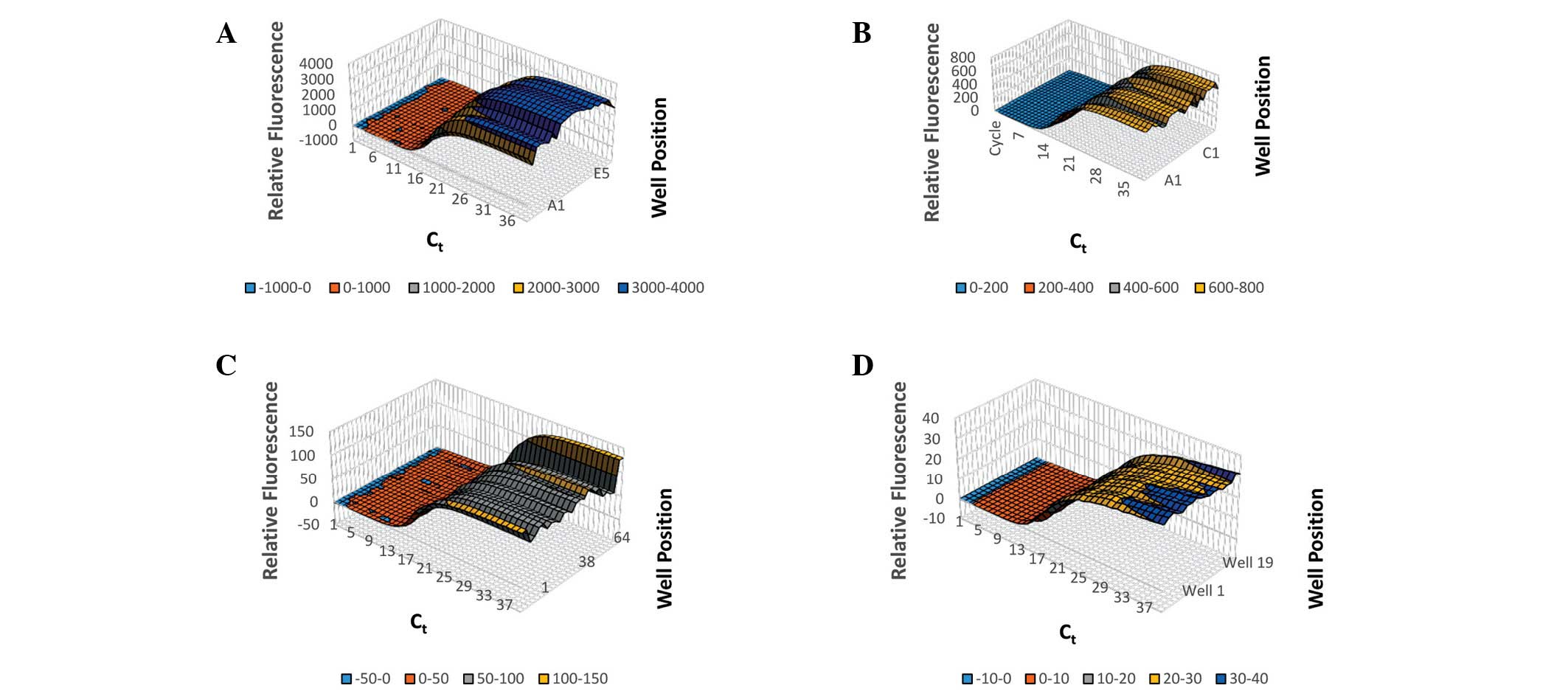
Amplification efficiency and thermal stability of qPCR instrumentation: Current landscape and future perspectives
- Authors:
- Karly‑Rai Rogers‑Broadway
- Emmanouil Karteris
-
View Affiliations
Affiliations: Department of Biosciences, Brunel University, Uxbridge UB8 3PH, UK
- Published online on: August 25, 2015 https://doi.org/10.3892/etm.2015.2712
-
Pages:
1261-1264
-
Copyright: © Rogers‑Broadway
et al. This
is an open access article distributed under the
terms of Creative
Commons Attribution License.
Abstract
Quantitative polymerase chain reaction (qPCR) is a method of amplifying and detecting small samples of genetic material in real time and is in routine use across many laboratories. Speed and thermal uniformity, two important factors in a qPCR test, are in direct conflict with one another in conventional peltier‑driven thermal cyclers. To overcome this, companies are developing novel thermal systems for qPCR testing. More recently, qPCR technology has developed to enable its use in point‑of‑care testing (POCT), where the test is administered and results are obtained in a single visit to a health provider, particularly in developing countries. For a system to be suitable for POCT it must be rapid and reliable. In the present study, the speed and thermal uniformity of four qPCR thermal cyclers currently available were compared, two of which use the conventional peltier/block heating method and two of which use novel heating and cooling methods. The time required to complete 40 cycles varied between 12 and 58 min, and the Ct values were comparable, ranging between 13.6 and 16.8. Therefore, the novel technologies investigated in the present study for qPCR instrumentation performed equally well compared with conventional qPCR instruments, in terms of amplification efficiency and thermal uniformity.
View References
|
1
|
Dooms M, Chango A and Abdel-Nour A:
Quantitative PCR (qPCR) and the guide to good practices MIQE:
adapting and relevance in the clinical biology context. Ann Biol
Clin (Paris). 72:265–269. 2014.(In French). PubMed/NCBI
|
|
2
|
Burroughs N and Karteris E:
Ultra-high-speed PCR instrument development. PCR, Technology
Current Innovations. Nolan T and Bustin SA: CRC Press; Florida: pp.
143–157. 2013, View Article : Google Scholar
|
|
3
|
Kavanagh I, Jones G and Nayab SN:
Significance of controls and standard curves in PCR. PCR
Troubleshooting and Optimization: The Essential Guide. Kennedy S
and Oswald N: Caister Academic Press. (Norfolk, UK). 67–78.
2011.
|
|
4
|
Muldrew KL: Molecular diagnostics of
infectious diseases. Curr Opin Pediatr. 21:102–111. 2009.
View Article : Google Scholar : PubMed/NCBI
|
|
5
|
Emmadi R, Boonyaratanakornkit JB,
Selvarangan R, et al: Molecular methods and platforms for
infectious diseases testing. A review of FDA-approved and cleared
assays. J Mol Diagn. 13:583–604. 2011. View Article : Google Scholar : PubMed/NCBI
|
|
6
|
Peterson LR, Hacek DM and Robicsek A: 5
million lives campaign. Case study: An MRSA intervention at
Evanston Northwestern Healthcare. Jt Comm J Qual Patient Saf.
33:732–738. 2007.PubMed/NCBI
|
|
7
|
Rodriguez R: Biomarker testing for
treatment of metastatic colorectal cancer: Role of the pathologist
in community practice. J Community Support Oncol. 12:27–32.
2014.PubMed/NCBI
|
|
8
|
Therkildsen C, Bergmann TK,
Henrichsen-Schnack T, Ladelund S and Nilbert M: The predictive
value of KRAS, NRAS, BRAF, PIK3CA and PTEN for anti-EGFR treatment
in metastatic colorectal cancer: A systematic review and
meta-analysis. Acta Oncol. 53:852–864. 2014. View Article : Google Scholar : PubMed/NCBI
|
|
9
|
Niemz A, Ferguson TM and Boyle DS:
Point-of-care nucleic acid testing for infectious diseases. Trends
Biotechnol. 29:240–250. 2011. View Article : Google Scholar : PubMed/NCBI
|
|
10
|
Wynberg E, Toner S, Wendt JK, Visser LG,
Breederveld D and Berg J: Business travelers' risk perception of
infectious diseases: Where are the knowledge gaps and how serious
are they? J Travel Med. 20:11–16. 2013. View Article : Google Scholar : PubMed/NCBI
|
|
11
|
Adair Rohani, Zukor K, Bonjour S, Wilburn
S, Kuesel AC, Hebert R and Fletcher ER: Limited electricity access
in health facilities of sub-Saharan Africa: A systematic review of
data on electricity access, sources and reliability. Glob Health
Sci Pract. 1:249–261. 2013. View Article : Google Scholar : PubMed/NCBI
|
|
12
|
Centers for Disease Control and
Prevention. Rapid Diagnostic Testing for Influenza: Information for
Health Care Professionals. http://www.cdc.gov/flu/professionals/diagnosis/rapidclin.htmAccessed.
September 5th–2014
|
|
13
|
Cosgrove SE, Sakoulas G, Perencevich EN,
Schwaber MJ, Karchmer AW and Carmeli Y: Comparison of mortality
associated with methicillin-resistant and methicillin-susceptible
Staphylococcus aureus bacteremia: A meta-analysis. Clin
Infect Dis. 36:53–59. 2003. View
Article : Google Scholar : PubMed/NCBI
|
|
14
|
Niemz A and Boyle DS: Nucleic acid testing
for tuberculosis at the point-of-care in high-burden countries.
Expert Rev Mol Diagn. 12:687–701. 2012. View Article : Google Scholar : PubMed/NCBI
|















